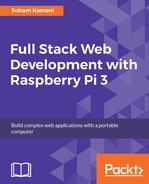Everything we did up to this point was restricted to the confines of the Raspberry Pi hardware. Although the Pi is a marvel of engineering in and of itself, it still comes with some limitations due to its small size. While hosting small-scale personal applications should not be much cause for concern, it would not be efficient to host a large-scale application entirely on the Pi.
In addition to this, letting others access your application would be another challenge altogether. How does one ensure that their Pi is always online when people need it? How can we take the load of multiple users without compromising our hardware? How can we ensure that the connectivity from the Pi (which is running in our home) is seamless to someone trying to access it potentially across the world?
The answer to all these questions is that it is nearly impossible for a single portable computer sitting on someone's personal internet connection to overcome the challenges of scale. In order to do this, we would have to leverage the power of the cloud. It's much easier than you think, and there are a large number of paid and free solutions meant for exactly these problems, out of which Firebase is one of the most prominent.
In this chapter, we will go through the Firebase platform and explore the various tools that Firebase provides that can help solve some of the problems mentioned earlier.
Here's a brief overview of topics covered in this chapter:
- The Firebase platform
- Migrating our application to Firebase
- Creating a Firebase application
- Initializing Firebase Realtime Database
- Modifying the client-side code to accommodate the Firebase API
